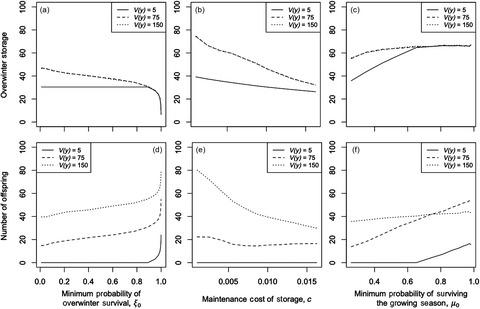Our official English website, www.x-mol.net, welcomes your feedback! (Note: you will need to create a separate account there.)
Optimal resource allocation and prolonged dormancy strategies in herbaceous plants
Journal of Ecology ( IF 5.5 ) Pub Date : 2020-07-11 , DOI: 10.1111/1365-2745.13466 J. Colton Watts 1 , Brigitte Tenhumberg 1
中文翻译:

草本植物的最佳资源分配和长期休眠策略
更新日期:2020-07-11
Journal of Ecology ( IF 5.5 ) Pub Date : 2020-07-11 , DOI: 10.1111/1365-2745.13466 J. Colton Watts 1 , Brigitte Tenhumberg 1
Affiliation

|
- Understanding the fitness consequences of different life histories is critical for explaining their diversity and for predicting effects of changing environmental conditions. However, current theory on plant life histories relies on phenomenological, rather than mechanistic, models of resource production.
- We combined a well‐supported mechanistic model of ontogenetic growth that incorporates differences in the size‐dependent scaling of gross resource production and maintenance costs with a dynamic optimization model to predict schedules of reproduction and prolonged dormancy (plants staying below ground for ≥1 growing season) that maximize lifetime offspring production.
- Our model makes three novel predictions: First, maintenance costs strongly influence the conditions under which a monocarpic or polycarpic life history evolves and how resources should be allocated to reproduction by polycarpic plants. Second, in contrast to previous theory, our model allows plants to compensate for low survival conditions by allocating a larger proportion of resources to storage and thereby improving overwinter survival. Incorporating this ecological mechanism in the model is critically important because without it our model never predicts significant investment into storage, which is inconsistent with empirical observations. Third, our model predicts that prolonged dormancy may evolve solely in response to resource allocation trade‐offs.
- Significance. Our findings reveal that maintenance costs and the effects of resource allocation on survival are primary determinants of the fitness consequences of different life history strategies, yet previous theory on plant life history evolution has largely ignored these factors. Our findings also validate recent arguments that prolonged dormancy may be an optimal response to costs of sprouting. These findings have broad implications for understanding patterns of plant life history variation and predicting plant responses to changing environments.
中文翻译:

草本植物的最佳资源分配和长期休眠策略
- 了解不同生活史的适应性后果对于解释其多样性和预测环境条件变化的影响至关重要。但是,当前有关植物生命史的理论依赖于现象学而非机制的资源生产模型。
- 我们将支持良好的个体发育生长机理模型与动态优化模型相结合,该模型将总资源生产和维护成本的大小依赖性缩放比例方面的差异与动态优化模型相结合,以预测繁殖时间表和长期休眠状态(植物在地下生长≥1个生长季节) ),最大限度地提高了后代的一生。
- 我们的模型做出了三个新颖的预测:首先,维护成本极大地影响了单生或多生生活史演变的条件,以及应如何分配资源以供多生植物繁殖。其次,与先前的理论相反,我们的模型允许植物通过分配更大比例的资源进行存储来补偿低生存条件,从而提高越冬生存率。将这种生态机制纳入模型至关重要,因为如果没有模型,我们的模型将永远无法预测对仓储的大量投资,这与经验观察结果不一致。第三,我们的模型预测,长期休眠可能仅根据资源分配的权衡而演变。
- 意义。我们的研究结果表明,维护成本和资源分配对生存的影响是不同生命史策略的适应性后果的主要决定因素,但是以前关于植物生命史演变的理论在很大程度上忽略了这些因素。我们的发现还证实了最近的论点,即长期休眠可能是对发芽成本的最佳反应。这些发现对理解植物生命史变异的模式以及预测植物对变化的环境的反应具有广泛的意义。


























 京公网安备 11010802027423号
京公网安备 11010802027423号